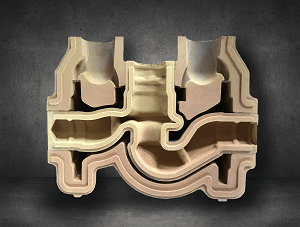
At NovaCast, we offer a wide range of casting process options as each have strengths and weaknesses that make them suited to certain applications and alloy choices. Shell Mould Casting is a metal casting process similar to sand casting, in that molten metal is poured into an expendable sand-based mould. However, in Shell Mould Casting, the mould is a thin-walled shell created by applying a heat-curing sand-resin mixture around a heated pattern. Once a cured shell has formed around the pattern, it is removed and reused to form multiple shell moulds. A reusable pattern allows for higher production rates, while the disposable moulds enable complex geometries to be cast.
Compared to sand casting, this process has better dimensional accuracy, good surface finish and consistency, a higher productivity rate, and lower labour requirements. It is often used for small to medium parts that require high precision.
Shell Mould Casting is used for both ferrous and non-ferrous metals. The most commonly used are cast iron, carbon steel, alloy steel, stainless steel, aluminium alloys, and copper alloys. Typical parts cast using this process are small-to-medium in size and require high accuracy, such as gear housings, cylinder heads, connecting rods, and lever arms.
To find out more about the advantages and disadvantages of the process see our Shell Mould Casting page.
To discuss your requirements, call a member of NovaCast’s team on +44 (0) 1225 707466, send us a message here or email sales@novacast.co.uk.